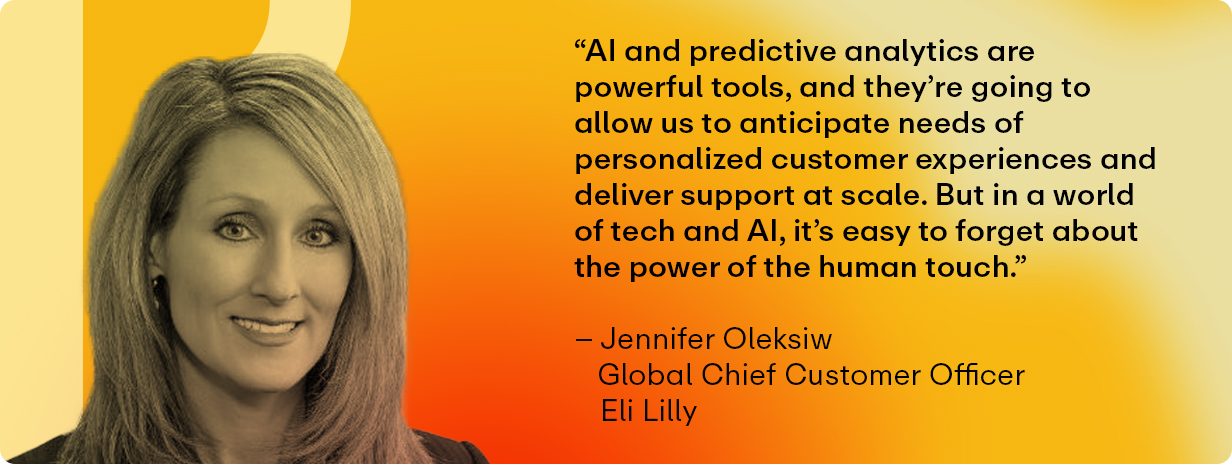Over the course of her 25 years at Eli Lilly, Jennifer Oleksiw has moved from coding systems to reinventing how a pharma giant connects with patients in the real world. In this Q&A excerpt from her podcast conversation with Kinara’s Chase Feiger, she shares how the company is melding digital technology, data and human empathy to reduce barriers in healthcare. She also talks about why true innovation in pharma requires looking outside the industry, staying curious and never being satisfied with the status quo.
(This Q&A has been edited for length and clarity. To listen to the full Kinara podcast with Jennifer Oleksiw, click here.)
Chase Feiger: You’ve been with Lilly for 25 years. How has your perspective on customer-centricity evolved across the roles that you’ve filled?
Jennifer Oleksiw: My understanding of customer-centricity has been shaped by almost every role that I’ve had, starting as a SAP configuration analyst and ABAP programmer and up to the role that I’m fortunate to have today, which is global chief customer officer. When I began my career at Lilly, it was clear that we were always putting the patient at the center of what we do. But as disruptive technology exploded and access to healthcare and behavioral data increased, we knew very quickly that we were going to be able to shift and meet more customers digitally. We were going to have a way to improve and personalize the overall customer experience at every step of the journey.
So today at Lilly, we are seeing customer-centricity through the lens of our brand truth, and that’s “health above all.” We’ve transformed the way that we’re engaging with our customers by embracing this holistic health approach. It’s one that looks at medicine well beyond the overall needs of a customer. That belief is deeply embedded in everything we do, from how we show up in advertising to the solutions that we bring to bear to the game-changing medicines that we deliver for our patients.
Feiger: How did partnering with diverse business units, including oncology and diabetes, shape your understanding of the patient and the healthcare provider journeys?
Oleksiw: Over the past 149 years, Lilly has focused on some of the toughest diseases with that singular focus of improving lives. A lot of people don’t know this, but Lily was the first to produce life-saving insulin for people with diabetes, the Salk vaccine to eradicate polio, fluoxetine to revolutionize depression care and vancomycin – which believe it or not, is still the last line of defense against antibiotic-resistant infections, nearly 75 years after it was invented. Along this journey, we’ve learned that every patient is unique, with distinctive needs and challenges and expectations.
It’s this diversity that underscores the importance we place on creating personalized approaches to care, empowering patients to take control of that healthcare journey and recognizing that care is not a one-size-fits-all journey. Now, from managing complex treatment regimens to navigating chronic conditions to removing stigma around disease, each patient’s journey highlights this critical need: that we have to simplify their access to care.
And managing these conditions has to become easier. These barriers strengthen our commitment to fostering innovation and developing tools that support both patients and healthcare providers. Whether that’s by improving access to our medicines or combining them with healthy habits along the way, or even leveraging new and disruptive technology to enhance their overall care delivery, our ultimate goal is to make healthcare more accessible and more personalized for the patients who need it most.
Feiger: As pharma has evolved, digital went from being a support function to a frontline capability – and you’ve been at the center of that shift during your time as global chief customer officer. What was the pivotal moment when digital engagement became mission-critical at Lilly?
Oleksiw: One moment that really sticks out is the creation of Lilly Direct. At Lilly, we recognize the significant friction that patients often face throughout their healthcare journey. Many individuals struggle to find the right doctor, to schedule appointments, to identify the right medications and, of course, to navigate the insurance coverage. And these challenges are probably even more pronounced for the 129 million Americans living with chronic disease who have to navigate a healthcare system that overlooks their needs. So with advancements in digital technology and shifting customer expectations, we identified this opportunity to improve the customer experience by creating a platform called Lilly Direct.
Lilly Direct was the first direct-to-consumer digital healthcare platform that allowed patients to get support across their entire end-to-end health journey. They had the opportunity on the platform to read information about their condition. They could find a doctor or access one via telehealth. They could receive safe and high quality products if prescribed a Lilly medication, and they could find ways to stay on the treatment plan by accessing content on diet, exercise, sleep and even stress management. It was this combination of being able to put innovative medicines and healthy behaviors together in a personalized experience that led to the outcomes these patients deserve.
Today it’s setting a new standard in healthcare, making healthcare simpler and personal, and built around the patient. But Chase, I must say this: We are far from satisfied and there is so much left to do to improve the overall experience of Lilly Direct. We’re excited to keep building on this innovation and to serve even more people around the world.
Feiger: How do you define omnichannel in today’s pharma landscape? What do you think brand teams often get wrong about it?
Oleksiw: In our landscape, it’s really about delivering a simple, connected, consistent and personalized experience across every touchpoint a customer has with our company, whether that’s through digital platforms or in-person interactions. It could be through a patient support program or even educational content. It’s not about one component that makes for a great customer experience; it is about capturing data compliantly so that you can actually target the right customer at the right time with the information that they need most.
Now what I think many brand teams, including ours, often get wrong at times is when we focus on pushing our own content rather than understanding where the customer is in their journey. With the explosion of technology, and with data and artificial intelligence, there’s no reason to follow these archaic processes anymore. So many brands also struggle with simplicity. For each interaction, they try to tell customers everything they need to know about the brand and lose them in the moment. If we think about these seconds or even fractions of seconds that we have on a TikTok video or an Instagram reel, we can quickly lose the customer if we provide them with too much.
Feiger: With AI and predictive analytics on the rise, how do you balance automation with empathy in customer experience? How do we stay human, or how do we make these interactions continue to feel human?
Oleksiw: This is definitely something everybody’s wrestling with. AI and predictive analytics are powerful tools, and they’re going to allow us to anticipate needs of personalized customer experiences and deliver support at scale. But in a world of tech and AI, it’s easy to forget about the power of the human touch. When we think about automation and empathy, we don’t see them as opposing forces, but as complimentary ones.
We’re trying to embrace the blend of tech, AI and human ingenuity that can solve some of the greatest healthcare challenges facing humanity today. There’s this movement to really transform healthcare, to appeal to an awakened consumer base that’s really hungry to take control of their own personal health journey. But they’re going to demand simplicity and personalization, and I can’t change content every step of the way. So AI is what will ultimately help us provide that personalization and improve that customer experience more quickly and at a scale we could never do before.
Feiger: These shifts don’t happen in a vacuum. What lessons have you learned about aligning commercial and medical teams toward shared outcomes?
Oleksiw: It’s so important to be able to do this across a large enterprise. When you consider the structure or the complexity of a matrix, all parties have to be aligned to the North Star. For us, that’s about making life better for people around the world. There’s also the stark reality that none of our patients suffering from diseases actually care where the information or service is coming from, whether it’s from marketing or medical or any other team.
We’ve had so many learnings along the way as we’ve moved closer to all these teams working together in lockstep. First, we quickly realized that content matters. The content should have a similar look and feel so that customers can recognize the Lilly name and our brands. This gives them that immediate trust in the medicine that we make, that it’s real and authentic. When we were working in silos in the past, different approaches to content only confused customers.
The second part is about using data and analytics across our various teams. It’s critical to ensure we are not overwhelming our customers. Without a coordinated approach across these different types of teams, a healthcare provider can quickly end up with maybe 10 digital tactics targeted at them and countless leaflets and printouts stacked up on their desk. Then finally, it comes back to what we talked about earlier. You have to get the right messaging and the right moment and the right channel all working in lockstep. Personalization is the icing on the cake. So working together as one Team Lilly has been fundamental for changing the customer experience.
Feiger: What’s a bold bet more pharma leaders should be making, but aren’t yet making?
Oleksiw: The most transformative ideas often come from the most unexpected places. Leaders who are committed to continuous growth and look ahead are best positioned to drive disruptive innovation, I think. More leaders should actively seek inspiration beyond their own industries, because success today isn’t just about being best in class. It’s about being best in any class. For me personally, the best learnings have come from listening to tech entrepreneurs from companies that have been built digitally from the ground up, and even from big consumer brands that constantly reinvent themselves while staying true to the values that got them there.
Leaders should always look for inspiration in what they see. It may seem obvious, but sometimes that’s inside their own place of work. We at Lilly are inspired by and learn from our own employees every day. But I think the most important thing, the bottom line of it all, is to always be curious, learn from others and never be satisfied.




